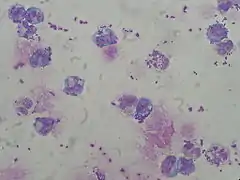Staphylococcus capitis
Staphylococcus capitis is a coagulase-negative species (CoNS) of Staphylococcus. It is part of the normal flora of the skin of the human scalp, face, neck,scrotum, and ears and has been associated with prosthetic valve endocarditis, but is rarely associated with native valve infection.[1]
| Staphylococcus capitis | |
|---|---|
 | |
| S. capitis in cerebrospinal fluid. | |
| Scientific classification | |
| Kingdom: | |
| Phylum: | |
| Class: | |
| Order: | |
| Family: | |
| Genus: | |
| Species: | S. capitis |
Clinical importance
CoNS produce a slimy biofilm enabling them to adhere to medical devices such as prosthetic valves and catheters and makes them difficult to remove by patient immune response to antibiotic therapy. As native flora of the skin and mucous membranes, they may be introduced anytime these are punctured, i.e. at the time of device placement, venipuncture, or through breaks in the mucous membrane or skin. CoNS species, such as S. epidermidis and S. capitis, are recorded as the most common cause of prosthetic valve endocarditis.[2][3][4]
S. capitis, fortunately, has a lower propensity to antibiotic resistance and also produces less biofilm than many other CoNS. This improves chances of successful eradication of S. capitis in periprosthetic infections (as total knee and total hip arthroplasty infections) relative to other CoNS such as S. epidermidis .[5]
New studies show that the organism can be taken from prosthetic joint infections, most likely contracted from surgery. This organism is shown in creating human disease and can easily be spread in the hospital so knowing where the bacteria comes from is vital in improving treatment algorithms in the future[6].
References
- Kloos, W. E.; Schleifer, K. H. (1975). "Isolation and Characterization of Staphylococci from Human Skin II. Descriptions of Four New Species: Staphylococcus warneri, Staphylococcus capitis, Staphylococcus hominis, and Staphylococcus simulans". International Journal of Systematic Bacteriology. 25 (1): 62–79. doi:10.1099/00207713-25-1-62. ISSN 0020-7713.
- Van Der Zwet WC, Debets-Ossenkopp YJ, Reinders E, et al. (July 2002). "Nosocomial spread of a Staphylococcus capitis strain with heteroresistance to vancomycin in a neonatal intensive care unit". J. Clin. Microbiol. 40 (7): 2520–5. doi:10.1128/JCM.40.7.2520-2525.2002. PMC 120592. PMID 12089273.
- D'mello D, Daley AJ, Rahman MS, et al. (September 2008). "Vancomycin heteroresistance in bloodstream isolates of Staphylococcus capitis". J. Clin. Microbiol. 46 (9): 3124–6. doi:10.1128/JCM.00592-08. PMC 2546727. PMID 18596138.
- Iwase T, Seki K, Shinji H, Mizunoe Y, Masuda S (October 2007). "Development of a real-time PCR assay for the detection and identification of Staphylococcus capitis, Staphylococcus haemolyticus and Staphylococcus warneri". J. Med. Microbiol. 56 (Pt 10): 1346–9. doi:10.1099/jmm.0.47235-0. PMID 17893172.
- Kloos WE PMC 358308, Update on clinical significance of coagulase-negative staphylococci. Clin Microbiol Rev. 1994 Jan; 7(1): 117–140
External links
- Tevell, S.; Hellmark, B.; Nilsdotter-Augustinsson, Å.; Söderquist, B. (2017). "Staphylococcus capitis isolated from prosthetic joint infections". European Journal of Clinical Microbiology & Infectious Diseases. 36 (1): 115–122. doi:10.1007/s10096-016-2777-7. PMC 5203848. PMID 27680718.
- Coagulase Negative Staphylococcus CNS
- Type strain of Staphylococcus capitis at BacDive - the Bacterial Diversity Metadatabase